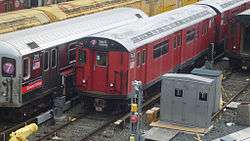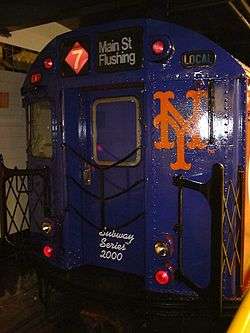R36 World's Fair (New York City Subway car)
| R36 World's Fair | |
|---|---|
|
R36 9401 at Corona Yard, Flushing, New York. This car along with its paired #9400 was scrapped on October 7, 2013. | |
|
This R36 World's Fair car is at the Flushing–Main Street station. This train was wrapped for the third game of the 2000 World Series at Shea Stadium. | |
| Manufacturer | St. Louis Car Company |
| Built at | St. Louis, Missouri, USA |
| Constructed | 1963–1964 |
| Entered service | 1963 |
| Refurbishment | 1981–1983, 1984–1986 |
| Scrapped | 2002-2003 |
| Number built | 390 |
| Number in service | (2 in work service) |
| Number preserved | 2 |
| Number scrapped | 386 [1] |
| Formation | Married pairs |
| Fleet numbers | 9346–9523, 9558–9769 |
| Capacity | 44 (seated) |
| Operator(s) | New York City Subway |
| Specifications | |
| Car body construction | LAHT (Low Alloy High Tensile) steel |
| Car length | 51.04 feet (15,560 mm) |
| Width | 8.75 feet (2,670 mm) |
| Height | 11.86 feet (3,610 mm) |
| Doors | 6 |
| Weight |
69,400 lb (31,500 kg) (pre-rebuild) 72,000 lb (33,000 kg) (rebuild units) |
| Traction system | Westinghouse XCA248 (cars 9346–9523), General Electric 17KG192 (cars 9558–9769) with Westinghouse (WH) 1447C or, General Electric (GE) 1240A5 DC motors (4/car, 100 hp or 75 kW) |
| Auxiliaries | Motor-generator and battery set (WH YX304E, GE 5GMG 153LI) |
| Electric system(s) | 600 V DC Third rail |
| Current collection method | Contact shoe |
| Braking system(s) | WABCO, "SMEE" (electrodynamic) |
| Headlight type | incandescent light bulbs |
| Track gauge | 4 ft 8 1⁄2 in (1,435 mm) standard gauge |
The R36 World's Fair (also known as R36 WF) or formerly known as the blue R36 New York City Subway cars, were built in 1963 and in 1964 by the St. Louis Car Company in St. Louis, Missouri for the IRT division (also known as the A Division). They were purchased for service on the IRT Flushing Line (7 <7> trains) which was the closest line to the 1964 New York World's Fair. These were the last entirely LAHT bodied (non-stainless) cars built for the New York City Subway.
History
Early history
In 1962, the New York City Transit Authority (NYCTA) ordered 430 cars for the 7 train. This route would run to the World's Fair grounds in Flushing Meadows in Queens. The first 40 cars were singles (R33 World's Fair), with the rest R36 cars. (Single cars were needed since the 7 service runs 11-car trains, and R36's were only pairs.) The cars were painted in a light blue turquoise "Bluebird" scheme (see "Paint Schemes" below) and with large picture windows unlike other IRT cars. Thirty-four R36s were built at the same time for the IRT Main Line, had small drop sash windows and were painted bright red. The first R36 cars (9558–9561) arrived in fall 1963, shortly after the R33 WF's began arriving in September. The first train of R36 Worlds Fair's was placed in service on the 7 line on October 24, 1963. With the fair opening approaching on April 12, 1964, R36 cars were built and delivered in larger quantities that Fall. More cars arrived throughout 1964, enough to displace the R12s, R14s and R15s from the 7 train by the close of 1964.
Through the 1970s, the R36s were the mainstay of the 7 service. The cars kept their original paint until 1977, when some were repainted in the new "Silver & Blue" scheme. Around 1975–78, the entire subway system was being covered in graffiti. Most cars had their original paint covered up by then or were given a new white "anti-graffiti" covering by 1982. By 1982, all cars had received air conditioning as part of a retrofitting program replacing the original Axiflow ceiling fans.[2]
Rebuilding

The R36s were the first cars to be rebuilt in the NYCTA's General Overhaul Program (GOH) in the 1980s. This program improved car life by rebuilding older cars and keeping other cars in a state of good repair. A trial rebuild program was done on selected Westinghouse R36 cars in 1981-83. Beginning in late 1984, the other R36 cars were rebuilt at rate of 200 cars per year, with the majority of them done in-house at the Coney Island Shop. Others were rebuilt by General Electric in Buffalo, New York and by Amtrak at its Beech Grove, Indiana and Wilmington, Delaware shops. The last remaining cars were sent out for rebuild in late 1985, and by 1986, all cars were back in service.
After rebuilding, the 7 service's R36 WF cars were repainted in a red scheme prior to returning to service. At first, the scheme was known as "Silver Fox" or "Gunn Red" or "Broad Street Red" after NYCT chief David L. Gunn and was a graffiti resistant red. By 1989, the Gunn Red would evolve into the Redbird scheme best known to many New Yorkers, with beige interiors, red exterior paint and interior doors and black and silver exterior trim along the car windows, roof, and undersides. In 1999, the R36 cars were the most reliable in the NYCT fleet, with a Mean Distance Between Failure (MDBF) rate of 194,150 miles, despite being 35 years old at the time. While in decent shape mechanically, rust holes and carbody corrosion were beginning to form in the sides of most of the cars.
In the 1990s and until mid-2001, cars 9478–9523 usually ran on the 6 train based at Westchester Yard in the Bronx. Previously, some Westinghouse R36 WFs had been assigned to the 1 and 3 trains in the 1970s.
Retirement
In 1998, New York City Transit announced that it would phase out its Redbird cars. The Redbirds—R26, R28, R29, R33 and R36—would be replaced by modern R142 and R142A cars. While the Redbirds on the IRT Main Line were beginning to be retired starting in early 2001, the 7 service was all Redbird until December 2001. In January 2002, a set of R62As arrived from the IRT Main Line. As more R142 sets were delivered, the 3 and 6 services would give up their R62A's to the 7, replacing R36s. R36 units were still the vast majority of Subway cars on the 7 in 2002, since R142 delivery was slow that year. By mid-2003 Redbird sets were dwindling on the 7 service. Only a few sets were running by fall. The last Redbird train ran along the 7 on November 3, 2003, marking the retirement of the Redbird cars and the end of non stainless steel cars in the subway.
Most of the Redbirds (1,294) were submerged off the coast of Delaware, New Jersey, South Carolina, Georgia and Virginia as artificial barrier and diving reefs, by Weeks Marine. Some of the remaining R36s have been set aside for various purposes, including work service:
- 9400-9401 were stored out of service in the Corona Yard for preservation. However, the cars were never used and were scrapped on October 7, 2013. Instead, cars 9586-9587 were used for preservation.
- 9564–9565 were set aside and transferred to Coney Island Yard in December 2004 for conversion of 9564 into a visitor center at Queens Borough Hall in Kew Gardens, Queens, and 9565 into a museum in West Babylon, New York. However, R33 ML #9075 was used instead. 9564-65 were subsequently reefed in 2008.
- 9582–9583, 9584–9585, and 9586–9587 were set aside for work service and were based in Unionport Yard. In July 2013, 9586–9587 were moved to Concourse Yard for storage. Since September 2013, these cars have been moved to 207th Street Yard for restoration to be part of the New York Transit Museum. Cars 9582–9583 and 9584–9585 remain at Unionport Yard, with 9582-9583 awaiting scrap. 9584-9585 are reported to remain active as part of the Rail Adhesion Car consist based at that yard as of November 2013. Cars 9586-9587 were on display at the Transit Museum and participated on their first fan trip on June 8, 2014 on the 7 line.
- 9588–9589 were based at Concourse Yard and were in storage until 2008, when this pair was also reefed.
In culture
Eight WH cars (9356–57, 9360–61, 9394–95, 9412–13) and two GE cars (9712–13) in addition to one R33 WF (9327) were wrapped and painted in New York Mets colors on October 24, 2000 prior to Game 3 of the 2000 World Series between the Yankees and Mets.
In addition, the R36 cars have made cameo roles in various TV shows and movies. They appear in several scenes in Spider-Man (2002), on The King of Queens and the opening credits of "NYPD Blue". Nicolas Cage rides the 7 in It Could Happen to You (1994). In the 1988 movie Cocktail, Tom Cruise gets off R36 9700 at Vernon-Jackson station. In Willard, Willard is seen boarding a Redbird.
Paint schemes
The R36 cars have worn many paint schemes since 1964.
- World's Fair Light Blue "Bluebird" (Turquoise blue) (1964–1982)
- NYCTA/MTA Silver & Blue (1977–1982 – newly retrofitted air conditioned units only)
- Plain Teflon based graffiti resistant White (1982–1988)
- Gunn Red or Broad Street Red, nickname: "Redbirds" (1985–2003)
Route assignment history
Some 9558–9769-series General Electric (GE) R36s were assigned to the IRT Main Lines #'s 2, 4 & 5 from 1982 to 1991 during the GOH/rebuilding program period to fill in for mainline cars sent out for rebuilding.
See also
- R33 World's Fair (New York City Subway car) – a single car version and a very similar model also built by St. Louis Car Company
References
External links
| |||||||||||||||||||||||||||||||||||||||||||||||||||||||||||




